Hello,
I've just bought a 2006 T5 LWB, which my Fiance and I will convert in to an off-grid camper in the coming year or so. The first job is leisure batteries.
I have been scouring the internet and indeed these forums for a wiring diagram of what I am after with no luck, so I hope one of you guys can help.
I would like to have 1 or 2 leisure batteries which are charged from either the engine alternator, solar power or mains hook-up. I would like however there to be a logic as to when each power source is used (or a combination) to charge the batteries.
I was thinking along these lines:
If solar voltage above X use solar,
When solar voltage below X use engine
When hook up voltage present use hook up
Essentially, I want a system which doesn't require any switching / buttons but will always use the favoured power source (solar or hookup) with engine alternator being backup for long periods on the road in winter / dark conditions. I'm not very electrically minded (mechanical engineer by trade) so my first thought was to code an arduino with a basic logic and some relays, but I am sure there is a better way?
Any help would be great! Here's the van if anyone is interested.
![175857 175857]()
I've just bought a 2006 T5 LWB, which my Fiance and I will convert in to an off-grid camper in the coming year or so. The first job is leisure batteries.
I have been scouring the internet and indeed these forums for a wiring diagram of what I am after with no luck, so I hope one of you guys can help.
I would like to have 1 or 2 leisure batteries which are charged from either the engine alternator, solar power or mains hook-up. I would like however there to be a logic as to when each power source is used (or a combination) to charge the batteries.
I was thinking along these lines:
If solar voltage above X use solar,
When solar voltage below X use engine
When hook up voltage present use hook up
Essentially, I want a system which doesn't require any switching / buttons but will always use the favoured power source (solar or hookup) with engine alternator being backup for long periods on the road in winter / dark conditions. I'm not very electrically minded (mechanical engineer by trade) so my first thought was to code an arduino with a basic logic and some relays, but I am sure there is a better way?
Any help would be great! Here's the van if anyone is interested.






